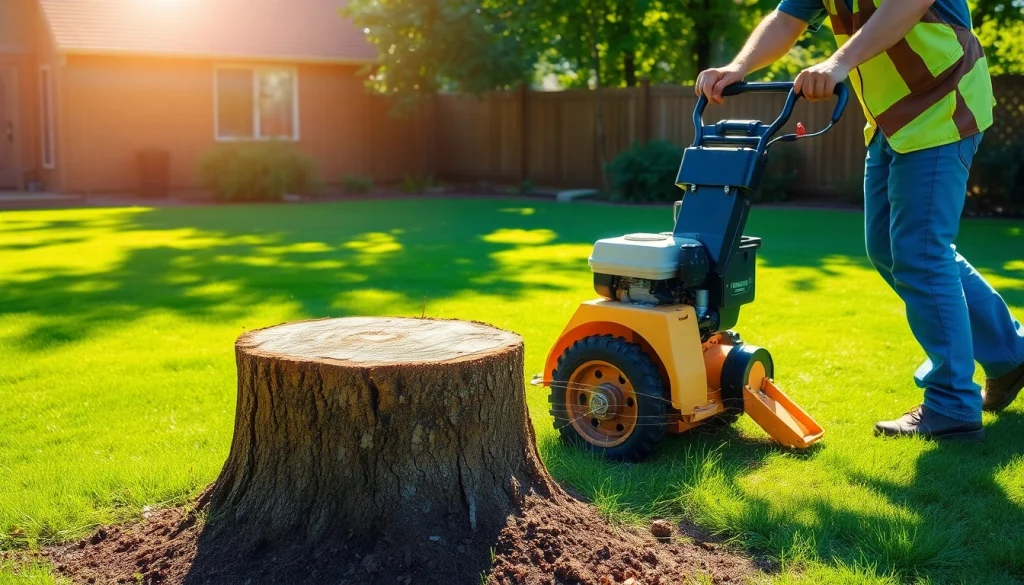
Understanding Stump Grinding Service
What is Stump Grinding?
Stump grinding is a professional landscaping process that involves the removal of tree stumps on a property by grinding them down into wood chips. Unlike traditional methods that often involve digging out the stump, stump grinding uses specialized machinery designed for this specific purpose. This method effectively reduces the remaining stump and root structure below ground, allowing for a flatter landscape that can be easily used for various purposes. By employing a stump grinding service, homeowners can ensure that their property not only looks more aesthetically pleasing but is also safer and more functional.
Benefits of Stump Grinding Services
The advantages of hiring a stump grinding service are numerous:
- Improved Aesthetics: Removing the unsightly stump enhances the property’s overall appearance.
- Increased Property Value: A well-maintained landscape contributes to higher property values.
- Safety: Stumps can pose trip hazards. Grinding them eliminates this risk, particularly in yards with children or pets.
- Preventing Pest Infestations: Stumps can attract pests, including ants, termites, and beetles. Grinding eliminates these potential infestations.
- Utilization of Space: After stump removal, the area can be repurposed for planting, landscaping, or other outdoor activities.
How Stump Grinding Differs from Other Methods
Stump grinding is often confused with stump removal, but the two processes are distinct. Stump removal involves extracting the entire stump and it’s root structure from the ground, which can be invasive and time-consuming. This method often leaves a large hole that needs to be filled and can cause disruption to the surrounding landscape. In contrast, stump grinding breaks down the stump into small chips, allowing the ground to settle naturally without large excavations. The grinding process is less invasive, quicker, and generally more cost-effective. Additionally, while removal leaves a gaping hole, stump grinding allows for immediate usability of the area following the service.
The Process of Stump Grinding
Step-by-Step Guide to Stump Grinding
Understanding the stump grinding process can help homeowners prepare for service. Here’s a step-by-step guide:
- Initial Assessment: A professional will assess the stump’s size, condition, and location to determine the appropriate equipment and technique.
- Site Preparation: Clearing the area around the stump of any debris, plants, or obstacles ensures safety and efficiency during the grinding process.
- Grinding: Using a stump grinder, the operator will grind the stump down to below ground level, typically 4 to 6 inches. The chipped wood can be left on-site or removed, depending on the homeowner’s preference.
- Cleanup: After grinding, cleanup involves collecting and disposing of the wood chips, which may be reused as mulch or organic waste.
- Post-Service Evaluation: A final inspection ensures that the area is safe, clean, and ready for further use or landscaping.
Choosing the Right Equipment for Stump Grinding Service
The type of equipment used for stump grinding can vary based on factors including stump size, location, and operator expertise. Common tools include:
- Stump Grinders: These come in various sizes from handheld models for small stumps to large, heavy-duty machines for bigger jobs.
- Chippers: Sometimes used in conjunction with stump grinding, these machines break down branches and other tree debris.
- Safety Gear: Operators should always wear appropriate gear including gloves, goggles, hearing protection, and steel-toe boots.
It’s essential to ensure that the service provider uses well-maintained and appropriate equipment for the job to guarantee efficiency and safety.
What to Expect During the Service
When hiring a stump grinding service, homeowners can expect a few key elements:
- Professionalism: A reputable service will arrive on time, equipped with the necessary tools, and dressed in professional attire.
- Communication: Expect clear communication regarding the process and any issues that may arise.
- Safety Measures: Look for operators to use safety protocols, ensuring minimal disruption to your property.
- Thoroughness: A quality service will ensure all stumps are ground to the appropriate depth and the surrounding area is left clean and tidy.
Choosing the Right Stump Grinding Service
Factors to Consider When Selecting a Provider
With various stump grinding services available, selecting the right one can be daunting. Here are critical factors to consider:
- Experience: Look for companies with a track record in stump grinding and tree care.
- Licensing and Insurance: Ensure that the provider is licensed and carries adequate insurance to protect against accidents.
- Equipment: Investigate the type of equipment they use. Advanced, well-maintained machinery often means better results.
- Pricing: Understand their pricing structure and get multiple quotes to compare services effectively.
Questions to Ask Your Stump Grinding Contractor
Before hiring a stump grinding service, consider asking the following questions:
- What methods do you use for stump grinding?
- Can you provide references or testimonials from previous clients?
- Do you have a guarantee or warranty for your work?
- How will you handle the debris post-grinding?
- What safety measures do you implement during the grinding process?
Evaluating Customer Reviews and Testimonials
Customer reviews can offer valuable insights into a stump grinding service’s reliability and quality. Look for comments regarding the following:
- Quality of Work: How satisfied were clients with the stump grinding results?
- Professionalism: Did they find the crew polite, punctual, and professional?
- Customer Service: How well did the company handle any complaints or follow-up questions?
- Value for Money: Were clients satisfied with the cost relative to the quality of service provided?
Cost Considerations for Stump Grinding Service
Understanding Pricing Models for Stump Grinding
When it comes to stump grinding, understanding the various pricing models can help homeowners budget accordingly. Pricing can be based on:
- Size of the Stump: Larger stumps typically cost more to grind due to the increased effort and time involved.
- Location: Stumps in difficult-to-reach areas, such as near buildings or fences, may incur additional charges.
- Labor Costs: Depending on the complexity of the job, labor costs can vary significantly from one service provider to another.
- Depth of Grinding: The expected depth of grinding may also influence the cost, with deeper grinds being more labor-intensive.
Cost-Saving Tips for Stump Grinding Services
Homeowners looking to save on stump grinding services can consider the following tips:
- Combine Services: If you have multiple stumps, inquire about discounts for concurrent grinding services.
- Off-Season Booking: Many landscaping services offer lower prices during off-peak seasons.
- Get Multiple Quotes: Compare estimates from different companies to ensure competitive pricing.
- DIY Preparation: Do preliminary work yourself, such as clearing brush and debris around the stump, to reduce labor costs.
Comparing Prices from Different Providers
When comparing prices from different stump grinding services, consider not just quotes but also what each includes. A lower price might not always translate to a better deal if the service lacks essential elements like cleanup or customer support. Here are suggestions to make comparisons more effective:
- Request Detailed Estimates: Seek itemized estimates that show labor, equipment use, and additional fees.
- Inquire About Packages: Some services may offer package deals for combined tasks, such as stump grinding and tree removal.
- Read Reviews: Customer feedback can help you gauge whether the service justifies its price.
- Check for Hidden Fees: Ensure you understand any variables that could affect the final price, such as permits or disposal costs.
Aftercare and Maintenance Post Stump Grinding
What to Do After Your Stump Grinding Service
Once the stump grinding service is complete, there are several steps to ensure the area is maintained properly:
- Fill the Hole: Consider filling the recess with topsoil or compost to support new plant life or sod.
- Water the Area: Watering helps settle the fill material and can promote healthy grass or plants in the area.
- Monitor for Pest Activity: Keep an eye out for pests that may infest the area due to residual organic matter.
- Plan for Planting: You might want to plant new grass or flowers in the area to further enhance your landscape.
Importance of Soil Health After Stump Removal
The health of the soil following stump grinding is crucial for a successful landscaping effort. The process breaks down organic material and enriches the soil, but it can also balance soil pH and nutrient levels. To maintain soil health:
- Test Soil: Run a soil test to determine nutrient levels and pH, guiding subsequent fertilizer application.
- Add Organic Matter: Incorporate organic compost to improve soil structure and fertility.
- Control Weeds: Monitor for and manage any invasive species that may take advantage of the cleared area.
Long-Term Benefits of Proper Stump Management
In the long term, addressing stumps through grinding and proper post-care greatly benefits a property:
- Aesthetic Appeal: Well-managed landscapes add beauty and character, increasing curb appeal.
- Healthier Ecosystems: Well-maintained soil fosters healthy growth of new plants, contributing to a sustainable ecosystem.
- Increased Useable Space: Clearing stumps opens up more area for activities, gardening, or landscaping projects.
- Reduced Risk of Pest Infestation: Consistent stump management prevents pest problems associated with decaying wood.






